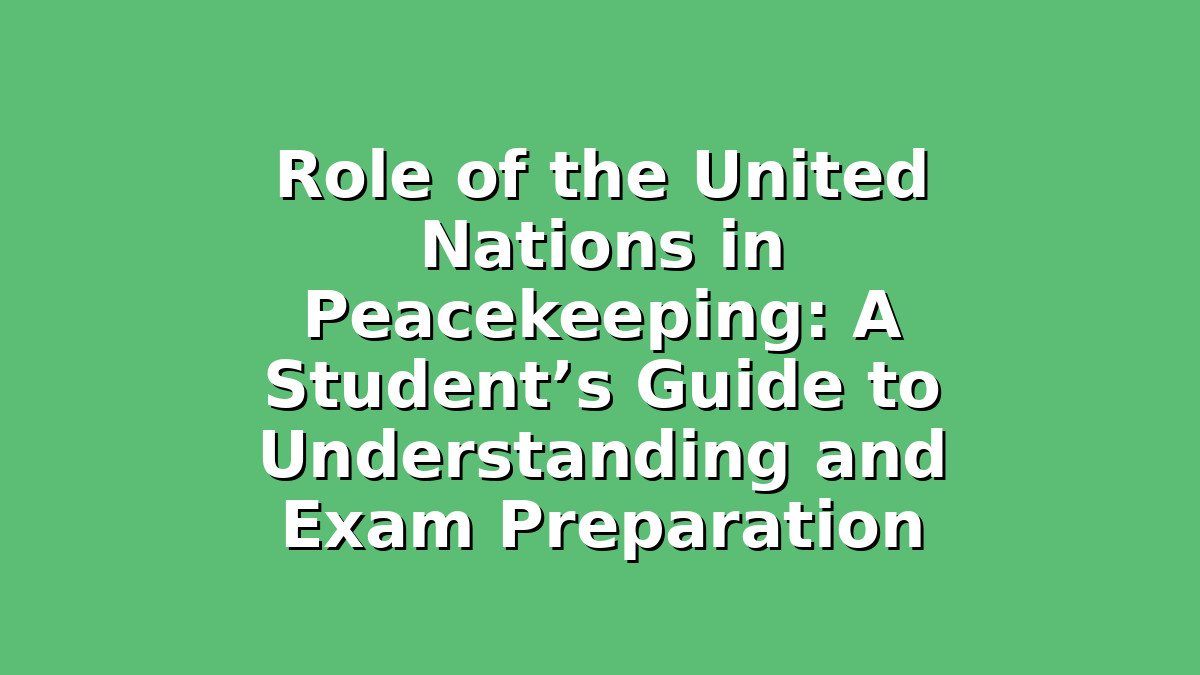Introduction
If you’re a student preparing for exams in subjects like political science, international relations, or history, understanding the role of the United Nations (UN) in peacekeeping is essential. The UN has been a key player in maintaining global peace and security since its founding in 1945. For many exam syllabi, knowledge about UN peacekeeping missions, their objectives, and challenges is a common topic. But the concept can sometimes feel complex and overwhelming.
Don’t worry! This article will break down the role of the United Nations in peacekeeping into easy-to-understand sections, along with practical study tips to help you master this topic efficiently. By the end, you’ll have a clear grasp of why the UN’s peacekeeping efforts matter and be better equipped to tackle exam questions confidently.
Section 1: Understanding the Basics of UN Peacekeeping
The first step in your study journey is to familiarize yourself with what UN peacekeeping actually means. Peacekeeping involves the deployment of international personnel—soldiers, police officers, and civilian staff—to conflict zones to help maintain peace and security. Unlike military interventions, UN peacekeeping operations are traditionally neutral and designed to support fragile peace processes.
Key components to focus on:
– Mandate: Each peacekeeping mission operates under a specific mandate authorized by the UN Security Council. This defines its goals, whether it’s monitoring ceasefires, protecting civilians, or assisting in political transitions.
– Principles: Peacekeeping is based on three fundamental principles: consent of the parties involved, impartiality, and the use of force only in self-defense.
– Types of Missions: Peacekeeping missions can vary, including traditional peacekeeping, peace enforcement, and peacebuilding operations.
Study Tip: Create flashcards for these key terms and principles. Reviewing them regularly can help reinforce your understanding and recall during exams. Use diagrams or mind maps to visualize how the different components relate to each other.
Section 2: Major UN Peacekeeping Operations and Their Impact
A good way to deepen your knowledge is by studying specific UN peacekeeping missions and their outcomes. This approach not only helps you remember facts but also gives you case examples to discuss in essays or exams.
Some important missions to know include:
– UNTSO (United Nations Truce Supervision Organization) – Established in 1948, it’s the UN’s first peacekeeping mission, monitoring ceasefires in the Middle East.
– UNIFIL (United Nations Interim Force in Lebanon) – Deployed in 1978 to confirm Israeli withdrawal and restore peace in Southern Lebanon.
– MONUSCO (United Nations Organization Stabilization Mission in the Democratic Republic of Congo) – One of the largest and longest-running missions, aimed at stabilizing the region and protecting civilians.
– MINUSMA (United Nations Multidimensional Integrated Stabilization Mission in Mali) – Focused on supporting political processes and counterterrorism in Northern Mali.
For each mission, focus on:
– Why it was deployed (context of the conflict).
– What the mission aimed to achieve.
– Challenges faced, such as lack of resources or political complexities.
– Outcomes and lessons learned.
Study Tip: When revising these missions, try writing short summaries or timelines. Connect the historical context with the mission’s goals to build a story around the facts — stories are easier to remember than isolated data.
Section 3: Challenges and the Future of UN Peacekeeping
No discussion about UN peacekeeping is complete without acknowledging its challenges and how it’s evolving. Understanding these issues demonstrates critical thinking in exams and can help you write balanced answers.
Challenges include:
– Resource Constraints: UN missions depend on member states for troops, funding, and equipment; sometimes these are insufficient or delayed.
– Complex Conflicts: Modern conflicts often involve non-state actors, terrorism, and asymmetric warfare, making peacekeeping more complicated.
– Political Obstacles: The Security Council’s veto power and differing national interests can delay or restrict peacekeeping mandates.
– Safety Risks: Peacekeepers often operate in dangerous environments, facing attacks and complex humanitarian crises.
Despite these challenges, UN peacekeeping continues to adapt by incorporating:
– More emphasis on protecting civilians.
– Greater use of technology and intelligence.
– Strengthened partnerships with regional organizations like the African Union.
Study Tip: To prepare for essay questions on challenges and future prospects, brainstorm pros and cons in a table format. This helps organize your thoughts clearly and prepares you to write analytical answers.
Conclusion
Mastering the role of the United Nations in peacekeeping is a valuable part of your exam preparation in international affairs. By understanding its basic principles, studying key missions, and reflecting on the challenges and future prospects, you build a solid foundation for both objective and essay-based questions.
Remember, effective study isn’t just about memorizing facts but connecting concepts, using examples, and practicing your writing. Use the study tips shared here—flashcards, summaries, timelines, and pros/cons tables—to improve retention and confidence.
Stay curious and motivated! The more you engage with the topic, the more interesting and manageable it becomes. Good luck with your exams, and keep aiming for that deep, meaningful understanding of global peace and security.

Responses